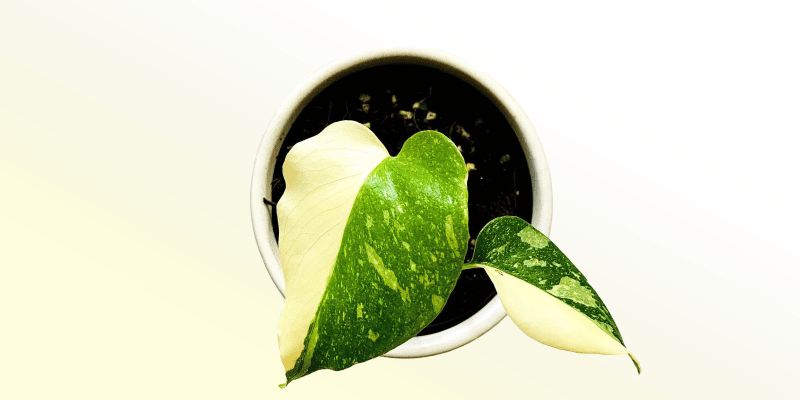It looks like a Monstera, but wait . . . something’s different. It’s definitely got the same shape and size, but its coloring is a lot splotchier. This plant almost resembles a Jackson Pollock painting, or a night sky speckled with white and yellow stars.
Hmm . . . could this be the elusive Thai Constellation Monstera? Bingo!
The Monstera deliciosa ‘Thai Constellation’ is undoubtedly one of the most beautiful variegated plants, but it’s extremely rare and has been a bit of a tease to plant lovers around the world.
Curious yet? I’ll explain, and give you some tips about how to care for the Thai Constellation plant along the way.
Table of Contents
Thai Constellation Monstera Care Guide
History, habitat, and characteristics
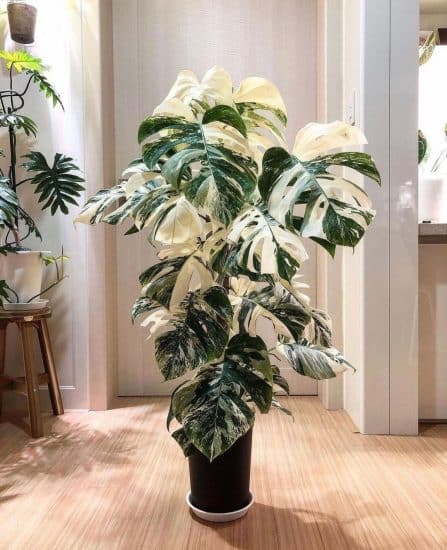
Monstera Thai Constellation is a unique species of the tropical climbing Monstera deliciosa. While its parent plant (the one with entirely green leaves) is from tropical areas of Central America, including southern Mexico and Panama, the Thai Constellation was developed in a tissue culture lab in Thailand (hence its name).
Although they have the same Swiss cheese-like holes, (fenestration!) as other variegated Monstera deliciosa, the Thai Constellation Monstera has a slightly different appearance.
- Monstera Albo Borsigiana, the only other type of variegated Monstera deliciosa, has more blocky concentrations of white on its leaves.
- Monstera Thai Consellation’s variegated leaves look like a spattering of creamy yellow and white stars spread across the night sky (if the sky were green, that is).
While it can reach heights of up to 20 feet outdoors, the Monstera Thai Constellation stays at four to eight feet indoors, with leaves that reach anywhere from 3 to 12 inches.
The Tropical Plant International Expo named the Monstera Thai Constellation Favorite New Foliage Plant, and plant lovers around the world added it to their must-have lists. How is such a popular plant still so hard to get?
Costa Farms promised to release the Monstera Thai Constellation en masse in 2021, then 2022 . . . Now it’s been postponed indefinitely due to persistent mass production issues. A handful have made it out into the world to select nurseries and individuals from Costa Farms, but its limited availability makes it a rare plant in high demand that can go for a hefty price.
Okay, now that you’re familiar with what the Thai Constellation Monstera looks like and have a little bit of its backstory, let’s get into its ideal care.
Light
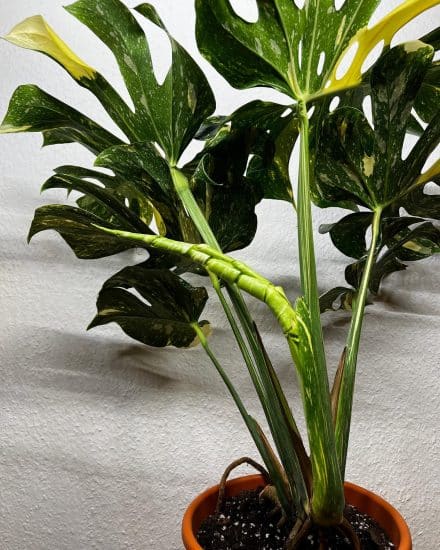
Monstera thai constellations need bright indirect light. Did you know that Monsteras have a back and a front? It’s true!
The Monstera’s roots are aerial, extending from the back, and its leaves are at the front. Because of this, you should place yours front-first near a window so its leaves receive plenty of natural bright light.
Monstera thai’s variegation is the result of more or less chlorophyll on sections of its leaves. A leaf with lighter white and cream sections has less chlorophyll and therefore requires more light to thrive than a solid color leaf.
So while Monstera thai constellation can tolerate low light conditions, especially for a variegated plant, it won’t thrive and you’ll likely see slow growth and even yellowing leaves.
Avoid direct sunlight, which can burn the leaves and cause them to turn yellow or brown. If you keep your plant near a southern-facing exposure or another area with direct sun, move it three to five feet away from the window to avoid scorching, or put up a curtain to create indirect sunlight instead.
If you are unsure about the lighting conditions in your home, you can use a light meter to measure the intensity of the light in the area where you plan to place the plant. This will help you determine if the plant is receiving the right amount of light. If it isn’t, consider using artificial grow lights to supplement.
Water
When deciding how often to water your Thai Constellation Monstera, don’t just water on a set schedule —take into consideration the season and environment you live in. During the warmer months of spring and summer, your plant requires more frequent watering than during the colder months of fall and winter.
To avoid overwatering, you can use a moisture meter to measure the soil’s dampness before watering or use the finger test. Simply poke a finger about an inch into the soil. If it feels dry, it’s time to water the plant. If it feels moist, hold off on watering for a few more days.
Since the Thai Constellation has aerial roots, it’s particularly susceptible to root rot from overwatering. To prevent waterlogging, allow water to completely drain through the pot and into the saucer each time you water your plant. Empty the saucer after each watering as well.
Temperature and humidity
Monstera Thai Constellations are tropical plants that crave warm room temperatures and high humidity. Their ideal temperature range is between 65 and 80 degrees Fahrenheit, but they can still thrive in hotter temperatures if the humidity and light levels are adequate.
In colder climates, keeping this plant indoors is essential, as it is not frost tolerant.
Humidity is particularly important for Monstera Thai Constellation, as it requires about 60% humidity for optimal growth. Symptoms of low humidity may include browning or curling leaves that may have a dry, papery texture. To increase the humidity for your plant, here are some helpful tips:
- Place the plant on a damp pebble tray – this is an inexpensive method to increase the humidity around your plant.
- Invest in a small humidifier – this is a great way to add humidity to the air regularly.
- Group plants together – bunching a few plants near each other can help to create a humid atmosphere.
Soil and planting
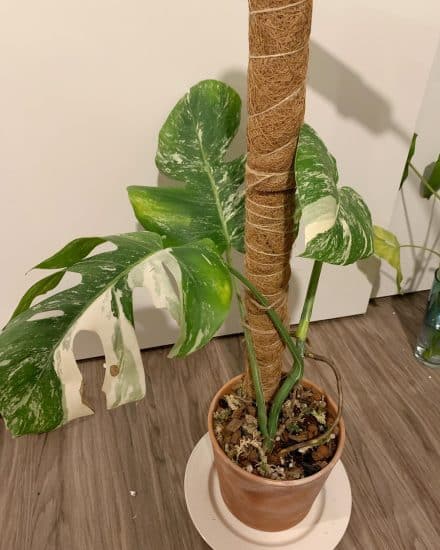
Your Thai Constellation Monstera will grow best in a well-draining soil mix that is specifically designed for aroids, with a pH between 5 and 7.5. You can buy one, like an orchid mix, or make your own. I suggest using something like the following mix:
- 60% potting soil
- 20% perlite
- 20% coco coir, sphagnum moss (peat moss), or bark chips
Feel free to throw in a handful of worm castings as well. This will result in potting soil that provides plenty of organic matter and nutrients. It’ll also retain moisture and drain well without weighing down or compacting the mix.
Fertilizing: For fertilizing, use a balanced liquid houseplant fertilizer at a diluted strength of 50% once a month during the spring and summer months. Avoid over-fertilizing, as this can cause chemical damage to the plant. Reduce fertilization during fall and winter months.
Pruning: You can prune your plant to remove dead leaves, or when its foliage grows too large. Be sure not to prune more than once annually, since Thai Constellations grow slowly and need time to produce more leaves.
Repotting
Since Monstera Thai Constellation is a slower grower than its parent, Monstera deliciosa, you’ll probably only need to repot it every 2 or 3 years. When repotting, take care not to disturb the root system too much and use a container that is only one or two inches larger than the existing one. Make sure the pot you choose has drainage holes (at least one) in the bottom so any excess water can escape.
Pro tip: While they aren’t necessary, moss poles can help your Monstera Thai constellation better mimic its natural forest environment, give it support, and help promote large, healthy leaves. If you notice its stems bending towards the floor or the plant tilting, consider staking it with a moss pole.
Ready to learn how to grow this Pollock-style masterpiece of a plant? Let’s get to it.
Propagation guide
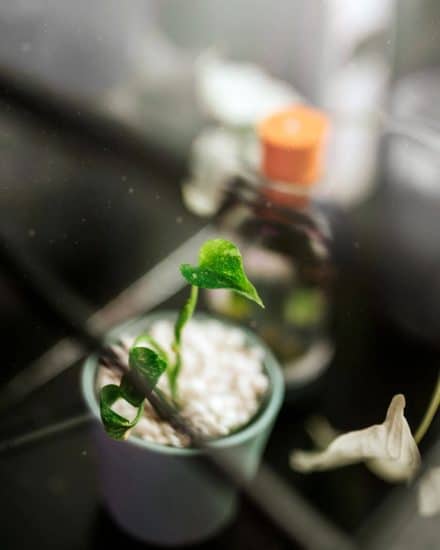
Propagating your own Thai Constellation Monstera indoors is an easy way to share the beauty of this plant with others or create more for your own enjoyment. It’s okay, you can hoard!
Using stem cuttings, or wet sticks, as they’re known in the plant world, is the easiest propagation method for a Thai Constellation.
To propagate a Thai Constellation Monstera by stem cuttings:
- Using a sharp, sterilized knife to cut a 4-6 inch section of stem from the mother plant, make sure to include at least five leaves and one node.
- Remove the lower leaves from the stem cutting, leaving only 2-3 at the top and exposing the stem nodes.
- If using a rooting hormone (optional), dip the cut end of the stem cutting into the hormone to encourage root growth.
- Fill a clean jar with water and place the cuttings in it, making sure the exposed nodes are submerged and the leaves are not.
- Place the jar in a bright, warm spot and change out the water every few days to ensure cleanliness.
- After several weeks, when the roots have grown a few inches—say, two or so—transfer the cutting to a pot filled with soil and begin fertilizing once a week.
Keep in mind that because this plant was developed in a laboratory via tissue culture, you cannot use Monstera Thai constellation seeds to propagate it. This means that all the Thai constellation plants in the world are clones of the mother plant!
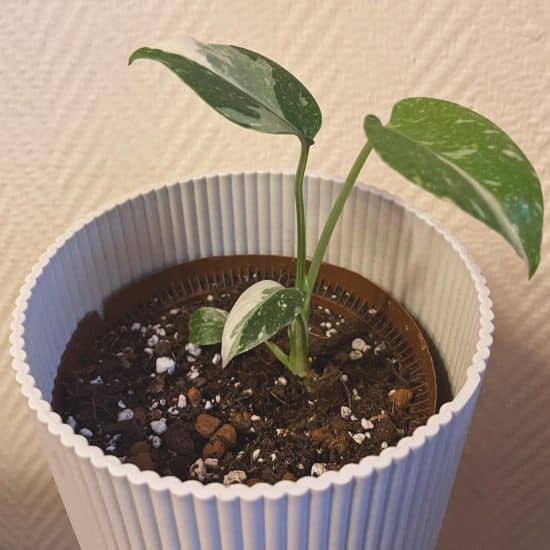
Fun fact: Unlike other similar species of variegated plants, such as the Monstera Albo Borsigiana, every cell of the Thai Constellation retains the same distinctive variegation. This makes it a much more stable form of variegated Monstera, since propagation isn’t somewhat of a guessing game, like it can be with Monstera albo—you know the Thai Constellation will have its trademark variegation no matter what!
(If you’re curious about the genetics behind variegated albo Monstera in general, take a look at this video from Baetanical —the variegated section starts at 8:05).
Common issues
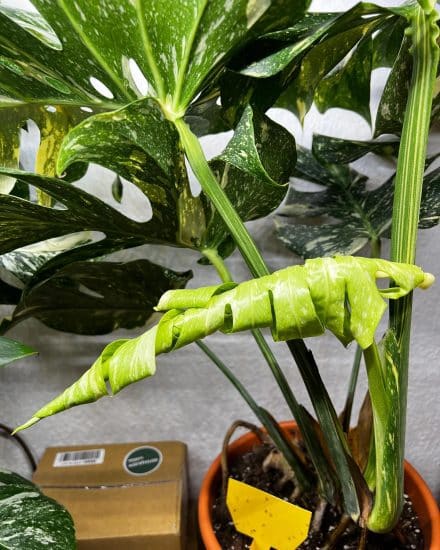
Worried about a sparse-looking plant or a few brown leaves? Fret no more! We’ll tell you what could be causing common issues with your Thai and how to fix them.
Leggy Growth: If your Thai Constellation Monstera is growing long and leggy stems, it’s likely not getting enough light. Along with legginess you’ll notice its leaves turning almost completely green. This combination always indicates a need for brighter light. If your plant is not getting enough light, its stems will naturally elongate in search of a better light source, or etiolate.
To fix this issue, move the plant to a location that receives brighter, more direct sunlight and make sure to rotate it periodically so that every leaf gets access to an equal amount of light.
Yellowing Leaves/Brown Leaves: This can have many causes, most having to do with over or underwatering, too much or little light, or overfertilization.
If your plant isn’t getting enough light, you may see slow or stunted growth, yellowing leaves, or a lack of new growth. On the other hand, if the plant is getting too much light, you may see the leaves turning yellow or brown, as well as wilting or drooping. They will also turn brown and yellow if under or overwatered.
Overfertilization can burn the roots of your Thai Constellation Monstera and lead to yellowing leaves and stunted growth. To determine if you are overfertilizing, check the color of the soil. If the soil has taken on a bright green or yellow hue, this is a sign that too much fertilizer has been added.
If this is the case, flush out the soil with fresh water to remove any excess chemicals and fertilize less frequency going forward.
Drooping Leaves: A super common issue for this plant. Drooping leaves are almost always caused by an issue with water frequency or water retention in the soil.
You really want to water your Thai Constellation as the soil completely dries out. If the potting mix is constantly moist or waterlogged, the roots may not be able to access enough oxygen, and this can also lead to drooping leaves. Wait for that soil to dry completely (at least the top few inches) and check the pot to make sure roots aren’t clogging its drains.
Diseases and pests
While this is an easy plant to care for, you still need to watch out for the early signs of disease or pests. Here are the problems we see most often:
Root Rot: Root rot is a common issue with Monstera Thai Constellation, as well as many other plants. It’s caused by too much moisture in the soil, leading to the roots becoming waterlogged and eventually dying. Signs of root rot include wilted and yellow leaves, as well as brown spots on the leaves.
To prevent this, make sure to let the soil dry out between waterings and avoid overwatering. If your plant is suffering from root rot, remove it from its pot, brush the dirt off its roots, snip off any dead or dying ones, and repot in fresh soil that drains well.
Fungal Diseases: Usually we see fungi like powdery mildew with these plants. Powdery mildew usually appears as a white powdery substance on the leaves and stems. The best prevention is to make sure it has good air flow and not to leave the leaves wet for too long. If you spot any signs of a fungal disease, take off any infected leaves and treat the plant with a fungicide.
Pests: Tiny pests like mealybugs, fungus gnats, aphids, and spider mites can also affect Monstera Thai Constellation. Mealybugs look like small, white, cottony masses on the plant, while aphids appear as tiny insects that come in various colors. Spider mites are tiny, spider-like insects that spin webs on the plant.
To keep away pests, make sure to check your Thai Constellation Monstera regularly for signs of infestation and quarantine any infected plants away from your other houseplants. To treat pests, try using a natural solution such as diluted neem oil or insecticidal soap.
Conclusion
One of the most coveted variegated varieties of Monstera deliciosa, the Thai Constellation Monstera is a unique plant with splatterings of bright green and creamy white variegation. While it can be a bit more sensitive to its light conditions than regular Monstera deliciosa due to its variegation, and its aerial roots can be more prone to rotting in soil that’s too dense, it isn’t a difficult plant to care for by any means.
Pay attention to your Thai’s environment, give it lots of warmth, humidity, and bright indirect light, and this beautiful plant will variegate its way right into your heart.
Were you lucky enough to snag a Thai Constellation Monstera? Tell us all about it in the comments! If you found this article helpful, feel free to share it with a friend.
FAQ
Is Thai Constellation Monstera rare?
Thai Constellation Monstera still hasn’t been officially released as of 2023, so it’s considered to be a very rare plant. Hopefully it will start propagating into more locations and if you have your own, make some clones and get them out into the world!
What is the difference between Thai Constellation and Monstera?
The main difference between these plants is in the unique variegation of the Thai Constellation. It has large leaves with colors ranging from dark green, cream, and white. Monstera deliciosa’s leaves are completely green with no variegation whatsoever, which also reduces its light requirements and increases its speed of growth.
Are Thai Constellations hard to care for?
Although they exhibit slower growth than other Monsteras, Thai constellation Monsteras are relatively easy to care for, as long as they are provided with the right conditions. Like most plants, they require well-draining soil, adequate water and light, and occasional fertilization. They dislike dense soil, so keep that in mind if formulating your own mix.

